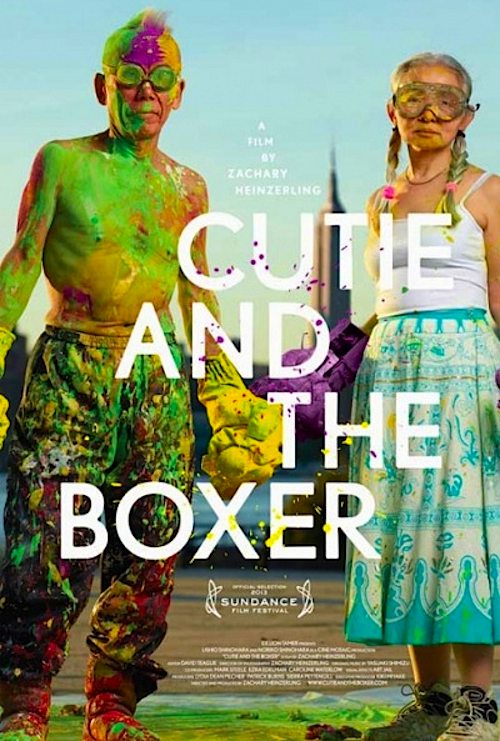 By Joe Bendel. Ushio Shinohara knows how to show a canvas who’s the boss. His wife Noriko knows how to do the same with Shinohara. However, it was not always thus. Their relationship has evolved over the years. Zachary Heinzerling documents the artists as they prepare for their first joint show in Cutie and the Boxer, which screened during the 2013 Sundance Film Festival.
By Joe Bendel. Ushio Shinohara knows how to show a canvas who’s the boss. His wife Noriko knows how to do the same with Shinohara. However, it was not always thus. Their relationship has evolved over the years. Zachary Heinzerling documents the artists as they prepare for their first joint show in Cutie and the Boxer, which screened during the 2013 Sundance Film Festival.
Ushio Shinohara’s unique brand of abstract expressionism involves paint soaked boxing gloves. One of the more cinematic artists to watch at work, Shinohara created several of his boxing paintings live in Park City for suitably impressed festivalers. He also has a considerable body of sculpture, but it is the painting for which he is best known. Alas, “known” is a relative term. Despite a burst of media attention when he arrived in 1969, lasting success has eluded the boxer.
Meeting Shinohara in New York as a naïve art student, Noriko put her career on hold to raise their son and to serve as her husband’s assistant. However, she is poised to eclipse his limited renown with her autobiographical comic art depicting the tempestuous relationship of the often naked “Cutie” and her alcoholic husband “Bullie.” “Ushi” is the Japanese word for “bull,” but the name perhaps holds a double meaning here.
Life with the Shinoharas sounds much quieter now that he has sworn off drinking. Unfortunately, their adult son seems to have picked up his father’s bad habits—a not uncommon phenomenon for children of alcoholics. Their interfamily dynamics are definitely complicated, but Heinzerling gives viewers enough contextualization to pick up on most of it.
Ushio Shinohara’s working process is interesting to watch. Noriko Shinohara’s work is interesting to read and absorb. That gives Heinzerling quite a bit material to shape into a film, particularly by the standards of most quietly contemplative art docs. Just Ushio Shinohara’s status as an eighty year old struggling artist lends the film ample dramatic tension.

Serving as his own cinematographer, Heinzerling gives C & B the straight forward observational doc treatment. However, the music of experimental/jazz/classical composer and Bach interpreter Yasuaki Shimizu adds a layer of aesthetic richness to the film, while sensitively accompanying the on-screen action. Whether or not the film will make Ushio Shinohara’s art more collectible, it should move quite a few Shimizu CDs (or downloads).
C & B examines the downside of hipsterdom, but it has a strong element of hope that will surely resonate with audiences. The Shinoharas keep doggedly plugging away, remaining faithful to their artistic visions. Hopefully, Heinzerling’s film will help spur wider recognition for them. Recommended for patrons of art documentaries and contemporary Japanese art, Cutie and the Boxer screened in Park City as part of the U.S. Documentary Competition at this year’s Sundance.
LFM GRADE: B
Posted on January 30th, 2012 at 3:33pm.
